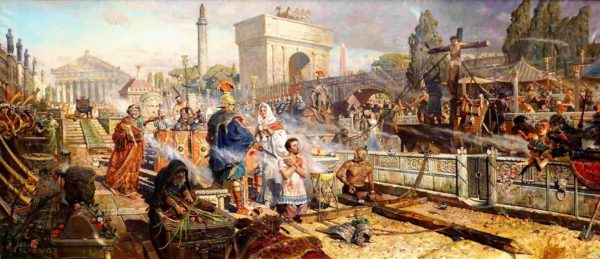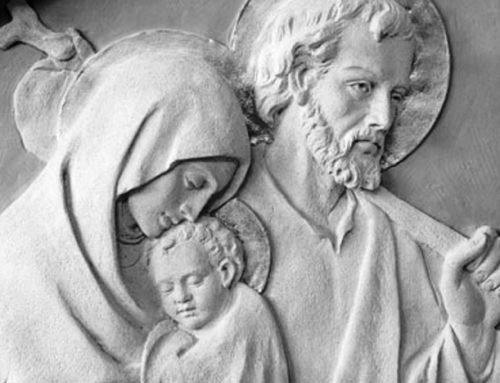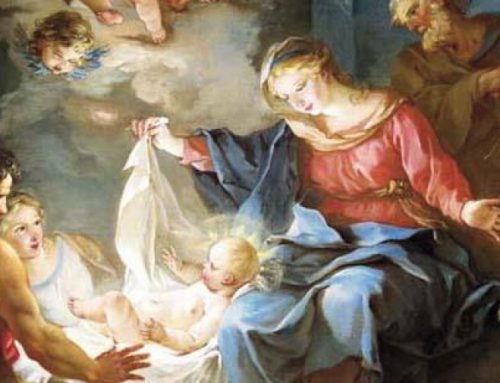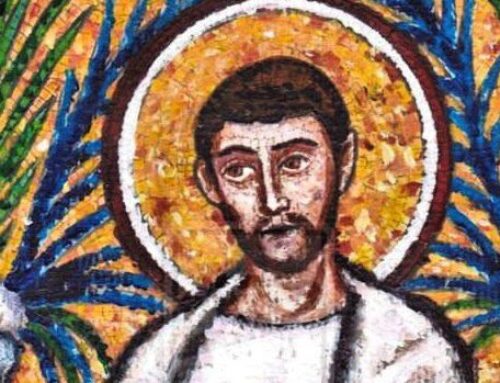The Greek word martus signifies a witness who testifies to a fact of which he has knowledge from personal observation. It is in this sense that the term first appears in Christian literature; the Apostles were “witnesses” of all that they had observed in the public life of Christ, as well as of all they had learned from His teaching, “inJerusalem, and in all Judea, and Samaria, and even to the uttermost part of the earth” (Acts 1:8). St. Peter, in his address to the Apostles and disciples relative to the election of a successor to Judas, employs the term with this meaning: “Wherefore, of these men who have accompanied with us all the time that the Lord Jesus came in and went out among us, beginning from the baptism of John until the day he was taken up from us, one of these must be made witness with us of his resurrection” (Acts 1:22). In his first public discourse the chief of theApostles speaks of himself and his companions as “witnesses” who saw the risen Christ and subsequently, after the miraculous escape of the Apostles from prison, when brought a second time before the tribunal, Peter again alludes to the twelve as witnesses to Christ, as the Prince and Saviour of Israel, Who rose from the dead; and added that in giving their public testimony to the facts, of which they were certain, they must obey God rather than man (Acts 5:29 sqq.). In his First Epistle St. Peter also refers to himself as a “witness of the sufferings of Christ” (1 Peter 5:1).
But even in these first examples of the use of the word martus in Christian terminology a new shade of meaning is already noticeable, in addition to the accepted signification of the term. The disciples of Christ were no ordinarywitnesses such as those who gave testimony in a court of justice. These latter ran no risk in bearing testimony to facts that came under their observation, whereas the witnesses of Christ were brought face to face daily, from the beginning of their apostolate, with the possibility of incurring severe punishment and even death itself. Thus,St. Stephen was a witness who early in the history of Christianity sealed his testimony with his blood. The careers of the Apostles were at all times beset with dangers of the gravest character, until eventually they all suffered the last penalty for their convictions. Thus, within the lifetime of the Apostles, the term martus came to be used in the sense of a witness who at any time might be called upon to deny what he testified to, under penalty of death. From this stage the transition was easy to the ordinary meaning of the term, as used ever since in Christianliterature: a martyr, or witness of Christ, is a person who, though he has never seen nor heard the Divine Founder of the Church, is yet so firmly convinced of the truths of the Christian religion, that he gladly suffers death rather than deny it. St. John, at the end of the first century, employs the word with this meaning; Antipas, a convert from paganism, is spoken of as a “faithful witness (martus) who was slain among you, where Satandwelleth” (Revelation 2:13). Further on the same Apostle speaks of the “souls of them that were slain for theWord of God and for the testimony (martyrian) which they held” (Revelation 6:9).
Yet, it was only by degrees, in the course of the first age of the Church, that the term martyr came to be exclusively applied to those who had died for the faith. The grandsons of St. Jude, for example, on their escape from the peril they underwent when cited before Domitian were afterwards regarded as martyrs (Eusebius, “Hist. eccl”, III, xx, xxxii). The famous confessors of Lyons, who endured so bravely awful tortures for their belief, were looked upon by their fellow-Christians as martyrs, but they themselves declined this title as of right belonging only to those who had actually died: “They are already martyrs whom Christ has deemed worthy to be taken up in their confession, having sealed their testimony by their departure; but we are confessors mean and lowly” (Eusebius, op. cit., V, ii). This distinction between martyrs and confessors is thus traceable to the latter part of the second century: those only were martyrs who had suffered the extreme penalty, whereas the title ofconfessors was given to Christians who had shown their willingness to die for their belief, by bravely enduringimprisonment or torture, but were not put to death. Yet the term martyr was still sometimes applied during the third century to persons still living, as, for instance, by St. Cyprian, who gave the title of martyrs to a number ofbishops, priests, and laymen condemned to penal servitude in the mines (Ep. 76). Tertullian speaks of those arrested as Christians and not yet condemned as martyres designati. In the fourth century, St. Gregory of Nazianzus alludes to St. Basil as “a martyr”, but evidently employs the term in the broad sense in which the word is still sometimes applied to a person who has borne many and grave hardships in the cause of Christianity. The description of a martyr given by the pagan historian Ammianus Marcellinus (XXII, xvii), shows that by the middle of the fourth century the title was everywhere reserved to those who had actually suffered death for their faith.Heretics and schismatics put to death as Christians were denied the title of martyrs (St. Cyprian, Treatise on Unity 14; St. Augustine, Ep. 173; Euseb., Church History V.16, V.21). St. Cyprian lays down clearly the general principle that “he cannot be a martyr who is not in the Church; he cannot attain unto the kingdom who forsakes that which shall reign there.” St. Clement of Alexandria strongly disapproves (Stromata IV.4) of some hereticswho gave themselves up to the law; they “banish themselves without being martyrs”.
The orthodox were not permitted to seek martyrdom. Tertullian, however, approves the conduct of the Christiansof a province of Asia who gave themselves up to the governor, Arrius Antoninus (Ad. Scap., v). Eusebius also relates with approval the incident of three Christians of Cæsarea in Palestine who, in the persecution of Valerian, presented themselves to the judge and were condemned to death (Church History VII.12). But while circumstances might sometimes excuse such a course, it was generally held to be imprudent. St. Gregory of Nazianzus sums up in a sentence the rule to be followed in such cases: it is mere rashness to seek death, but it iscowardly to refuse it (Orat. xlii, 5, 6). The example of a Christian of Smyrna named Quintus, who, in the time ofSt. Polycarp, persuaded several of his fellow believers to declare themselves Christians, was a warning of what might happen to the over-zealous: Quintus at the last moment apostatized, though his companions persevered.Breaking idols was condemned by the Council of Elvira (306), which, in its sixtieth canon, decreed that a Christianput to death for such vandalism would not be enrolled as a martyr. Lactantius, on the other hand, has only mildcensure for a Christian of Nicomedia who suffered martyrdom for tearing down the edict of persecution (Do mort. pers., xiii). In one case St. Cyprian authorizes seeking martyrdom. Writing to his priests and deacons regardingrepentant lapsi who were clamouring to be received back into communion, the bishop after giving general directions on the subject, concludes by saying that if these impatient personages are so eager to get back to theChurch there is a way of doing so open to them. “The struggle is still going forward”, he says, “and the strife is waged daily. If they (the lapsi) truly and with constancy repent of what they have done, and the fervour of theirfaith prevails, he who cannot be delayed may be crowned” (Ep. xiii).
Legal basis of the persecutions
Acceptance of the national religion in antiquity was an obligation incumbent on all citizens; failure to worship the gods of the State was equivalent to treason. This universally accepted principle is responsible for the variouspersecutions suffered by Christians before the reign of Constantine; Christians denied the existence of and therefore refused to worship the gods of the state pantheon. They were in consequence regarded as atheists. It istrue, indeed, that the Jews also rejected the gods of Rome, and yet escaped persecution. But the Jews, from theRoman standpoint, had a national religion and a national God, Jehovah, whom they had a full legal right toworship. Even after the destruction of Jerusalem, when the Jews ceased to exist as a nation, Vespasian made no change in their religious status, save that the tribute formerly sent by Jews to the temple at Jerusalem was henceforth to be paid to the Roman exchequer. For some time after its establishment, the Christian Churchenjoyed the religious privileges of the Jewish nation, but from the nature of the case it is apparent that the chiefs of the Jewish religion would not long permit without protest this state of things. For they abhorred Christ’s religion as much as they abhorred its Founder. At what date the Roman authorities had their attention directed to the difference between the Jewish and the Christian religion cannot be determined, but it appears to be fairly well established that laws proscribing Christianity were enacted before the end of the first century. Tertullian is authority for the statement that persecution of the Christians was institutum Neronianum — an institution of Nero— (Ad nat., i, 7). The First Epistle of St. Peter also clearly alludes to the proscription of Christians, as Christians, at the time it was written (I, St. Peter, iv, 16). Domitian (81-96) also, is known to have punished with deathChristian members of his own family on the charge of atheism (Suetonius, “Domitianus”, xv). While it is therefore probable that the formula: “Let there be no Christians” (Christiani non sint) dates from the second half of the first century, yet the earliest clear enactment on the subject of Christianity is that of Trajan (98-117) in his famous letter to the younger Pliny, his legate in Bithynia.
Pliny had been sent from Rome by the emperor to restore order in the Province of Bithynia-Pontus. Among the difficulties he encountered in the execution of his commission one of the most serious concerned the Christians. The extraordinarily large number of Christians he found within his jurisdiction greatly surprised him: the contagion of their “Superstition”, he reported to Trajan, affected not only the cities but even the villages and country districts of the province (Pliny, Ep., x, 96). One consequence of the general defection from the statereligion was of an economic order: so many people had become Christians that purchasers were no longer found for the victims that once in great numbers were offered to the gods. Complaints were laid before the legaterelative to this state of affairs, with the result that some Christians were arrested and brought before Pliny forexamination. The suspects were interrogated as to their tenets and those of them who persisted in declining repeated invitations to recant were executed. Some of the prisoners, however, after first affirming that they wereChristians, afterwards, when threatened with punishment, qualified their first admission by saying that at one time they had been adherents of the proscribed body but were so no longer. Others again denied that they were or ever had been Christians. Having never before had to deal with questions concerning Christians Pliny applied to the emperor for instructions on three points regarding which he did not see his way clearly: first, whether the age of the accused should be taken into consideration in meting out punishment; secondly, whether Christians who renounced their belief should be pardoned; and thirdly, whether the mere profession of Christianity should be regarded as a crime, and punishable as such, independent of the fact of the innocence or guilt of the accused of the crimes ordinarily associated with such profession.
To these inquiries Trajan replied in a rescript which was destined to have the force of law throughout the second century in relation to Christianity. After approving what his representative had already done, the emperor directed that in future the rule to be observed in dealing with Christians should be the following: no steps were to be taken by magistrates to ascertain who were or who were not Christians, but at the same time, if any personwas denounced, and admitted that he was a Christian, he was to be punished — evidently with death.Anonymous denunciations were not to be acted upon, and on the other hand, those who repented of beingChristians and offered sacrifice to the gods, were to be pardoned. Thus, from the year 112, the date of this document, perhaps even from the reign of Nero, a Christian was ipso facto an outlaw. That the followers of Christwere known to the highest authorities of the State to be innocent of the numerous crimes and misdemeanors attributed to them by popular calumny, is evident from Pliny’s testimony to this effect, as well as from Trajan’sorder: conquirendi non sunt. And that the emperor did not regard Christians as a menace to the State is apparent from the general tenor of his instructions. Their only crime was that they were Christians, adherents of an illegalreligion. Under this regime of proscription the Church existed from the year 112 to the reign of Septimius Severus(193-211). The position of the faithful was always one of grave danger, being as they were at the mercy of everymalicious person who might, without a moment’s warning, cite them before the nearest tribunal. It is true indeed, that the delator was an unpopular person in the Roman Empire, and, besides, in accusing a Christian he ran the risk of incurring severe punishment if unable to make good his charge against his intended victim. In spite of the danger, however, instances are known, in the persecution era, of Christian victims of delation.
The prescriptions of Trajan on the subject of Christianity were modified by Septimius Severus by the addition of a clause forbidding any person to become a Christian. The existing law of Trajan against Christians in general was not, indeed, repealed by Severus, though for the moment it was evidently the intention of the emperor that it should remain a dead letter. The object aimed at by the new enactment was, not to disturb those alreadyChristians, but to check the growth of the Church by preventing conversions. Some illustrious convert martyrs, the most famous being Sts. Perpetua and Felicitas, were added to the roll of champions of religious freedom by this prohibition, but it effected nothing of consequence in regard to its primary purpose. The persecution came to an end in the second year of the reign of Caracalla (211-17). From this date to the reign of Decius (250-53) theChristians enjoyed comparative peace with the exception of the short period when Maximinus the Thracian (235-38) occupied the throne. The elevation of Decius to the purple began a new era in the relations betweenChristianity and the Roman State. This emperor, though a native of Illyria, was nevertheless profoundly imbued with the spirit of Roman conservatism. He ascended the throne with the firm intention of restoring the prestige which the empire was fast losing, and he seems to have been convinced that the chief difficulty in the way of effecting his purpose was the existence of Christianity. The consequence was that in the year 250 he issued an edict, the tenor of which is known only from the documents relating to its enforcement, prescribing that allChristians of the empire should on a certain day offer sacrifice to the gods.
This new law was quite a different matter from the existing legislation against Christianity. Proscribed though they were legally, Christians had hitherto enjoyed comparative security under a regime which clearly laid down the principle that they were not to be sought after officially by the civil authorities. The edict of Decius was exactly the opposite of this: the magistrates were now constituted religious inquisitors, whose duty it was to punish Christians who refused to apostatize. The emperor’s aim, in a word, was to annihilate Christianity by compelling every Christian in the empire to renounce his faith. The first effect of the new legislation seemed favourable to the wishes of its author. During the long interval of peace since the reign of Septimius Severus — nearly forty years — a considerable amount of laxity had crept into the Church’s discipline, one consequence of which was, that on the publication of the edict of persecution, multitudes of Christians besieged the magistrates everywhere in their eagerness to comply with its demands. Many other nominal Christians procured by briberycertificates stating that they had complied with the law, while still others apostatized under torture. Yet after this first throng of weaklings had put themselves outside the pale of Christianity there still remained, in every part of the empire, numerous Christians worthy of their religion, who endured all manner of torture, and death itself, for their convictions. The persecution lasted about eighteen months, and wrought incalculable harm.
Before the Church had time to repair the damage thus caused, a new conflict with the State was inaugurated by an edict of Valerian published in 257. This enactment was directed against the clergy — bishops, priests, anddeacons — who were directed under pain of exile to offer sacrifice. Christians were also forbidden, under pain of death, to resort to their cemeteries. The results of this first edict were of so little moment that the following year, 258, a new edict appeared requiring the clergy to offer sacrifice under penalty of death. Christian senators,knights, and even the ladies of their families, were also affected by an order to offer sacrifice under penalty of confiscation of their goods and reduction to plebeian rank. And in the event of these severe measures provingineffective the law prescribed further punishment: execution for the men, for the women exile. Christian slavesand freedmen of the emperor’s household also were punished by confiscation of their possessions and reduction to the lowest ranks of slavery. Among the martyrs of this persecution were Pope Sixtus II and St. Cyprian of Carthage. Of its further effects little is known, for want of documents, but it seems safe to surmise that, besides adding many new martyrs to the Church’s roll, it must have caused enormous suffering to the Christian nobility. The persecution came to an end with the capture (260) of Valerian by the Persians; his successor, Gallienus (260-68), revoked the edict and restored to the bishops the cemeteries and meeting places.
From this date to the last persecution inaugurated by Diocletian (284-305) the Church, save for a short period in the reign of Aurelian (270-75), remained in the same legal situation as in the second century. The first edict ofDiocletian was promulgated at Nicomedia in the year 303, and was of the following tenor: Christian assemblies were forbidden; churches and sacred books were ordered to be destroyed, and all Christians were commanded toabjure their religion forthwith. The penalties for failure to comply with these demands were degradation and civil death for the higher classes, reduction to slavery for freemen of the humbler sort, and for slaves incapacity to receive the gift of freedom. Later in the same year a new edict ordered the imprisonment of ecclesiastics of all grades, from bishops to exorcists. A third edict imposed the death-penalty for refusal to abjure, and granted freedom to those who would offer sacrifice; while a fourth enactment, published in 304, commanded everybody without exception to offer sacrifice publicly. This was the last and most determined effort of the Roman State to destroy Christianity. It gave to the Church countless martyrs, and ended in her triumph in the reign ofConstantine.
Number of the martyrs
Of the 249 years from the first persecution under Nero (64) to the year 313, when Constantine established lasting peace, it is calculated that the Christians suffered persecution about 129 years and enjoyed a certain degree of toleration about 120 years. Yet it must be borne in mind that even in the years of comparative tranquillity Christians were at all times at the mercy of every person ill-disposed towards them or their religion in the empire. Whether or not delation of Christians occurred frequently during the era of persecution is not known, but taking into consideration the irrational hatred of the pagan population for Christians, it may safely be surmised that not a few Christians suffered martyrdom through betrayal. An example of the kind related by St. Justin Martyr shows how swift and terrible were the consequences of delation. A woman who had been convertedto Christianity was accused by her husband before a magistrate of being a Christian. Through influence the accused was granted the favour of a brief respite to settle her worldly affairs, after which she was to appear in court and put forward her defence. Meanwhile her angry husband caused the arrest of the catechist, Ptolomæusby name, who had instructed the convert. Ptolomæus, when questioned, acknowledged that he was a Christianand was condemned to death. In the court, at the time this sentence was pronounced, were two persons who protested against the iniquity of inflicting capital punishment for the mere fact of professing Christianity. The magistrate in reply asked if they also were Christians, and on their answering in the affirmative both were ordered to be executed. As the same fate awaited the wife of the delator also, unless she recanted, we have here an example of three, possibly four, persons suffering capital punishment on the accusation of a man actuated bymalice, solely for the reason that his wife had given up the evil life she had previously led in his society (St. Justin Martyr, II, Apol., ii).
As to the actual number of persons who died as martyrs during these two centuries and a half we have no definite information. Tacitus is authority for the statement that an immense multitude (ingens multitudo) wereput to death by Nero. The Apocalypse of St. John speaks of “the souls of them that were slain for the word ofGod” in the reign of Domitian, and Dion Cassius informs us that “many” of the Christian nobility suffered death for their faith during the persecution for which this emperor is responsible. Origen indeed, writing about the year 249, before the edict of Decius, states that the number of those put to death for the Christian religion was not very great, but he probably means that the number of martyrs up to this time was small when compared with the entire number of Christians (cf. Allard, “Ten Lectures on the Martyrs”, 128). St. Justin Martyr, who owed hisconversion largely to the heroic example of Christians suffering for their faith, incidentally gives a glimpse of the danger of professing Christianity in the middle of the second century, in the reign of so good an emperor asAntoninus Pius (138-61). In his “Dialogue with Trypho” (cx), the apologist, after alluding to the fortitude of his brethren in religion, adds, “for it is plain that, though beheaded, and crucified, and thrown to wild beasts, and chains, and fire, and all other kinds of torture, we do not give up our confession; but, the more such things happen, the more do others in larger numbers become faithful. . . . Every Christian has been driven out not only from his own property, but even from the whole world; for you permit no Christian to live.” Tertullian also, writing towards the end of the second century, frequently alludes to the terrible conditions under which Christians existed(“Ad martyres”, “Apologia”, “Ad Nationes”, etc.): death and torture were ever present possibilities.
But the new régime of special edicts, which began in 250 with the edict of Decius, was still more fatal toChristians. The persecutions of Decius and Valerian were not, indeed, of long duration, but while they lasted, and in spite of the large number of those who fell away, there are clear indications that they produced numerousmartyrs. Dionysius of Alexandria, for instance, in a letter to the Bishop of Antioch tells of a violent persecutionthat took place in the Egyptian capital, through popular violence, before the edict of Decius was even published. The Bishop of Alexandria gives several examples of what Christians endured at the hands of the pagan rabble and then adds that “many others, in cities and villages, were torn asunder by the heathen” (Eusebius, Church HistoryVI.41 sq.). Besides those who perished by actual violence, also, a “multitude wandered in the deserts and mountains, and perished of hunger and thirst, of cold and sickness and robbers and wild beasts” (Eusebius, l. c.). In another letter, speaking of the persecution under Valerian, Dionysius states that “men and women, young and old, maidens and matrons, soldiers and civilians, of every age and race, some by scourging and fire, others by the sword, have conquered in the strife and won their crowns” (Id., op. cit., VII, xi). At Cirta, in North Africa, in the same persecution, after the execution of Christians had continued for several days, it was resolved to expedite matters. To this end the rest of those condemned were brought to the bank of a river and made to kneelin rows. When all was ready the executioner passed along the ranks and despatched all without further loss oftime (Ruinart, p. 231).
But the last persecution was even more severe than any of the previous attempts to extirpate Christianity. InNicomedia “a great multitude” were put to death with their bishop, Anthimus; of these some perished by the sword, some by fire, while others were drowned. In Egypt “thousands of men, women and children, despising the present life, . . . endured various deaths” (Eusebius, Church History VII.4 sqq.), and the same happened in many other places throughout the East. In the West the persecution came to an end at an earlier date than in the East, but, while it lasted, numbers of martyrs, especially at Rome, were added to the calendar (cf. Allard, op. cit., 138 sq.). But besides those who actually shed their blood in the first three centuries account must be taken of the numerous confessors of the Faith who, in prison, in exile, or in penal servitude suffered a daily martyrdom more difficult to endure than death itself. Thus, while anything like a numerical estimate of the number of martyrs is impossible, yet the meagre evidence on the subject that exists clearly enough establishes the fact that countlessmen, women and even children, in that glorious, though terrible, first age of Christianity, cheerfully sacrificedtheir goods, their liberties, or their lives, rather than renounce the faith they prized above all.
Trial of the martyrs
The first act in the tragedy of the martyrs was their arrest by an officer of the law. In some instances theprivilege of custodia libera, granted to St. Paul during his first imprisonment, was allowed before the accused were brought to trial; St. Cyprian, for example, was detained in the house of the officer who arrested him, and treated with consideration until the time set for his examination. But such procedure was the exception to the rule; the accused Christians were generally cast into the public prisons, where often, for weeks or months at a time, they suffered the greatest hardships. Glimpses of the sufferings they endured in prison are in rare instances supplied by the Acts of the Martyrs. St. Perpetua, for instance, was horrified by the awful darkness, the intense heat caused by overcrowding in the climate of Roman Africa, and the brutality of the soldiers (Passio SS. Perpet., et Felic., i). Other confessors allude to the various miseries of prison life as beyond their powers of description (Passio SS. Montani, Lucii, iv). Deprived of food, save enough to keep them alive, of water, of light and air; weighted down with irons, or placed in stocks with their legs drawn as far apart as was possible without causing a rupture; exposed to all manner of infection from heat, overcrowding, and the absence of anything like proper sanitary conditions — these were some of the afflictions that preceded actual martyrdom. Many naturally, died inprison under such conditions, while others, unfortunately, unable to endure the strain, adopted the easy means of escape left open to them, namely, complied with the condition demanded by the State of offering sacrifice.
Those whose strength, physical and moral, was capable of enduring to the end were, in addition, frequently interrogated in court by the magistrates, who endeavoured by persuasion or torture to induce them to recant. These tortures comprised every means that human ingenuity in antiquity had devised to break down even the most courageous; the obstinate were scourged with whips, with straps, or with ropes; or again they were stretched on the rack and their bodies torn apart with iron rakes. Another awful punishment consisted in suspending the victim, sometimes for a whole day at a time, by one hand; while modest women in addition were exposed naked to the gaze of those in court. Almost worse than all this was the penal servitude to which bishops,priests, deacons, laymen and women, and even children, were condemned in some of the more violentpersecutions; these refined personages of both sexes, victims of merciless laws were doomed to pass the remainder of their days in the darkness of the mines, where they dragged out a wretched existence, half naked, hungry, and with no bed save the damp ground. Those were far more fortunate who were condemned to even the most disgraceful death, in the arena, or by crucifixion.
Honours paid the martyrs
It is easy to understand why those who endured so much for their convictions should have been so greatlyvenerated by their co-religionists from even the first days of trial in the reign of Nero. The Roman officials usually permitted relatives or friends to gather up the mutilated remains of the martyrs for interment, although in some instances such permission was refused. These relics the Christians regarded as “more valuable than gold or precious stones” (Martyr. Polycarpi, xviii). Some of the more famous martyrs received special honours, as for instance, in Rome, St. Peter and St. Paul, whose “trophies”, or tombs, are spoken of at the beginning of the third century by the Roman priest Caius (Eusebius, Church History II.21.7). Numerous crypts and chapels in theRoman catacombs, some of which, like the capella grœca, were constructed in sub-Apostolic times, also bearwitness to the early veneration for those champions of freedom of conscience who won, by dying, the greatest victory in the history of the human race. Special commemoration services of the martyrs, at which the holySacrifice was offered over their tombs — the origin of the time — honoured custom of consecrating altars by enclosing in them the relics of martyrs — were held on the anniversaries of their death; the famous Fractio Panisfresco of the capella grœca, dating from the early second century, is probably a representation (see s.v. FRACTIO PANIS; SYMBOLS OF EUCHARIST) in miniature, of such a celebration. From the age of Constantine even still greater veneration was accorded the martyrs. Pope Damasus (366-84) had a special love for the martyrs, as we learn from the inscriptions, brought to light by de Rossi, composed by him for their tombs in the Roman catacombs. Later on veneration of the martyrs was occasionally exhibited in a rather undesirable form; many of the frescoes in the catacombs have been mutilated to gratify the ambition of the faithful to be buried near thesaints (retro sanctos), in whose company they hoped one day to rise from the grave. In the Middle Ages the esteem in which the martyrs were held was equally great; no hardships were too severe to be endured in visiting famous shrines, like those of Rome, where their relics were contained.








Leave A Comment
You must be logged in to post a comment.